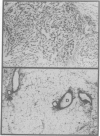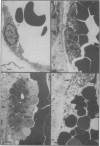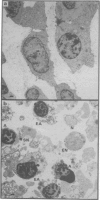Abstract
The aim of this study was to investigate mechanisms of anti-tumour activity and necrosis induced by combinations of tumour necrosis factor alpha (TNF-alpha) and interferon gamma (IFN-gamma). In a breast cancer xenograft model, locally injected recombinant human TNF-alpha arrested growth of established tumours in the absence of overt necrosis. Macroscopic necrosis occurred when rat IFN-gamma, which had no anti-tumour activity as a single agent, was given systemically. Treatment with TNF-alpha and IFN-gamma caused focal engorgement of tumour capillaries with erythrocytes, intravascular recruitment of polymorphonuclear cells and platelet adherence to the tumour vascular endothelium 4 h after the combined treatment. This was followed by destruction of tumour vascular endothelium and both necrosis and apoptosis of tumour cells. Concomitant with these changes, semiquantitative reverse transcriptase-polymerase chain reaction (RT-PCR) analysis revealed the increase of stromal (murine) mRNA levels for TNF-alpha, TNF receptor 55 kDa, TNF receptor 75 kDa, intracellular adhesion molecule 1, vascular cell adhesion molecule 1, P-selectin and interleukin 6 (IL-6). Thus, the effect of the combined TNF-alpha and IFN-gamma therapy involved the selective destruction of the tumour vasculature, death of tumour cells and increased expression of a series of stromal cytokines, cytokine receptors and adhesion molecules, which could be implicated in the observed events.
Full text
PDF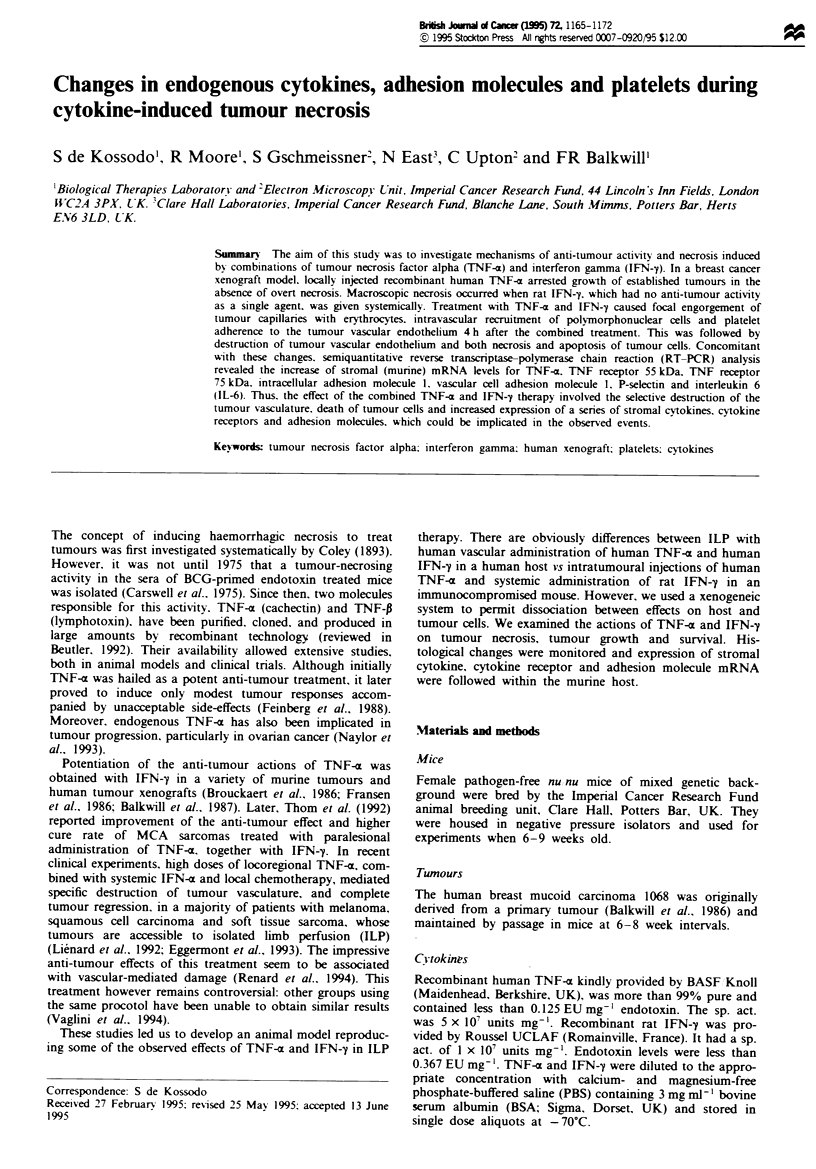
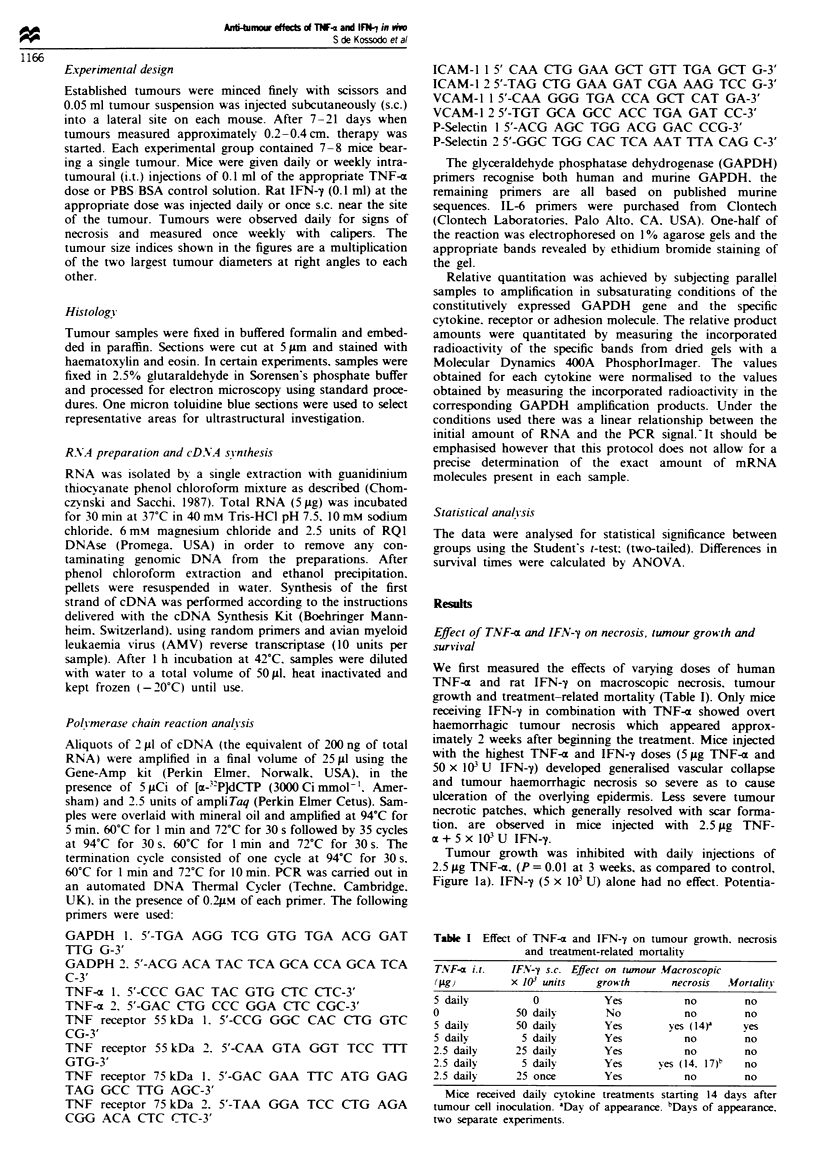
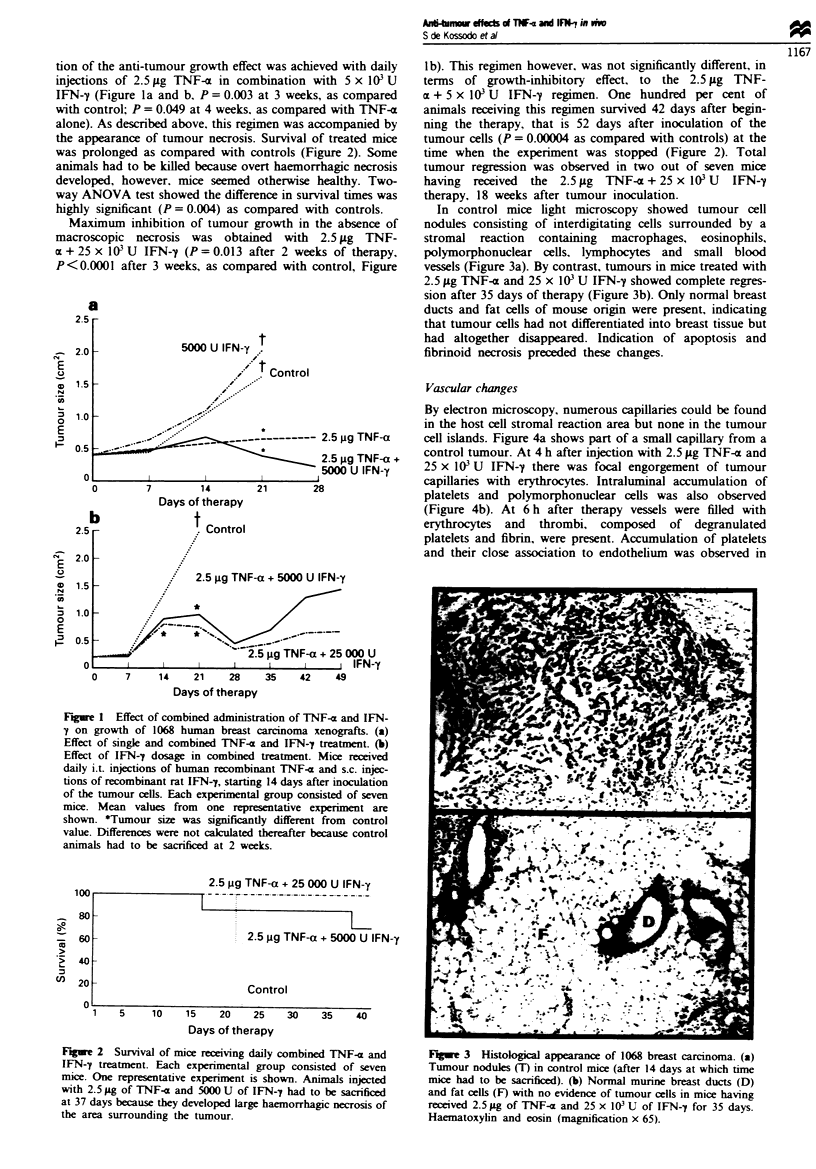
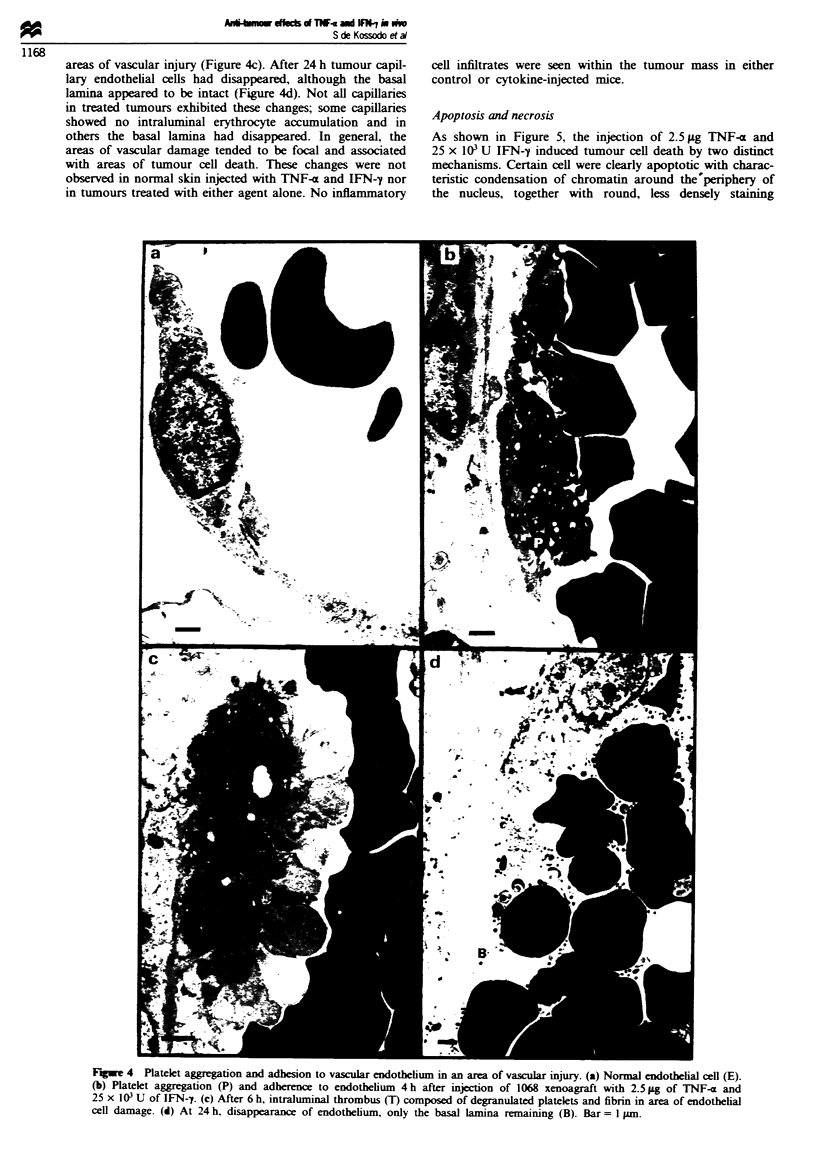
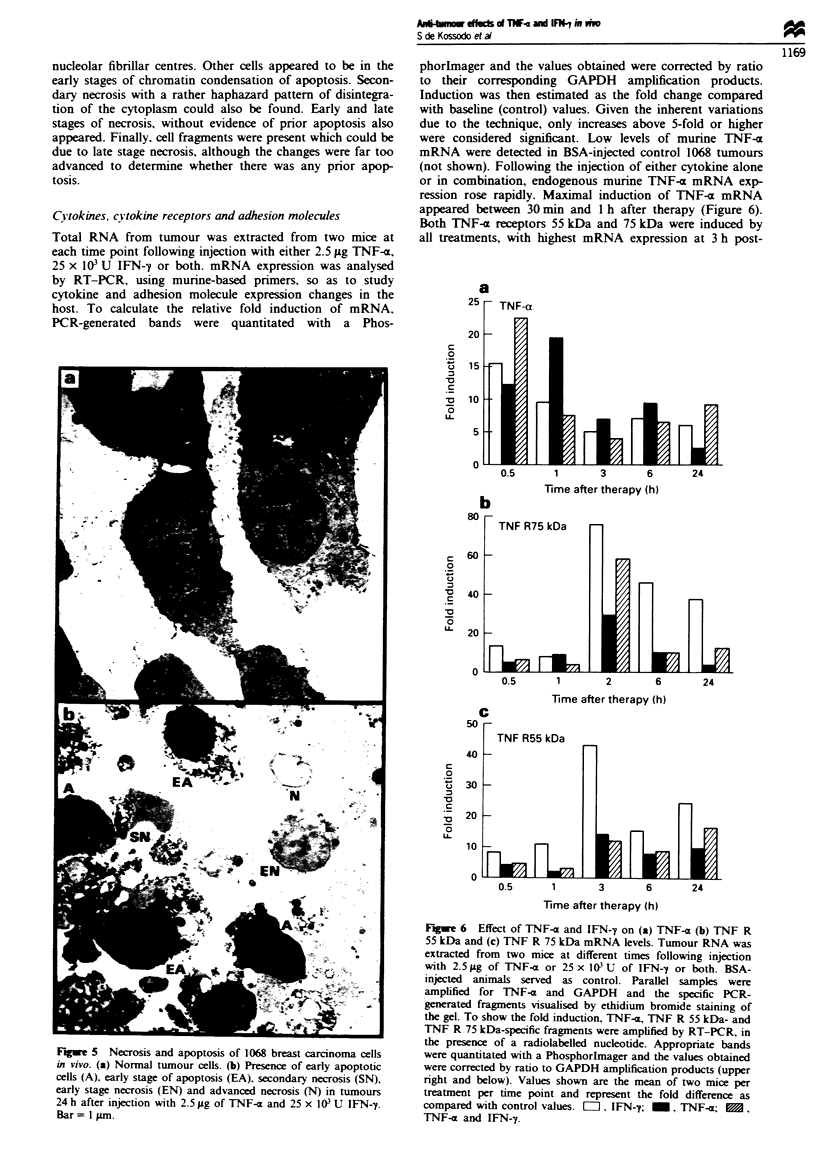
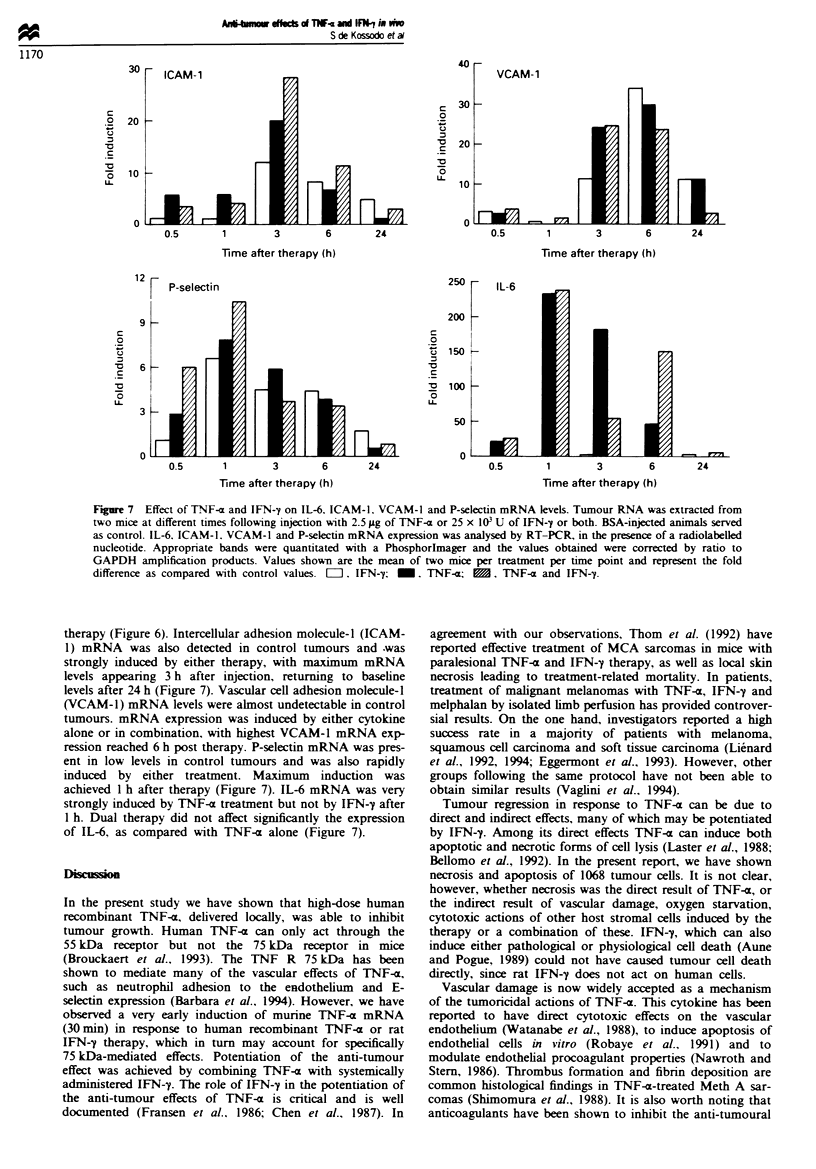
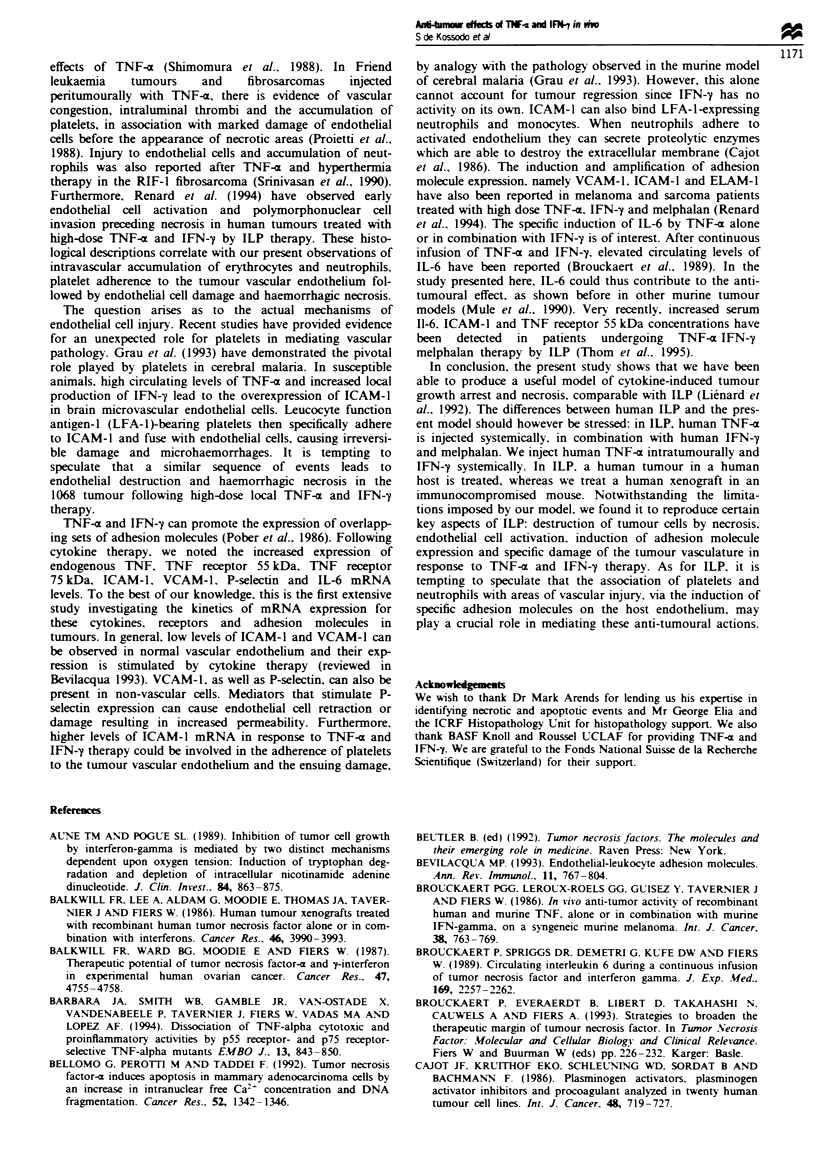
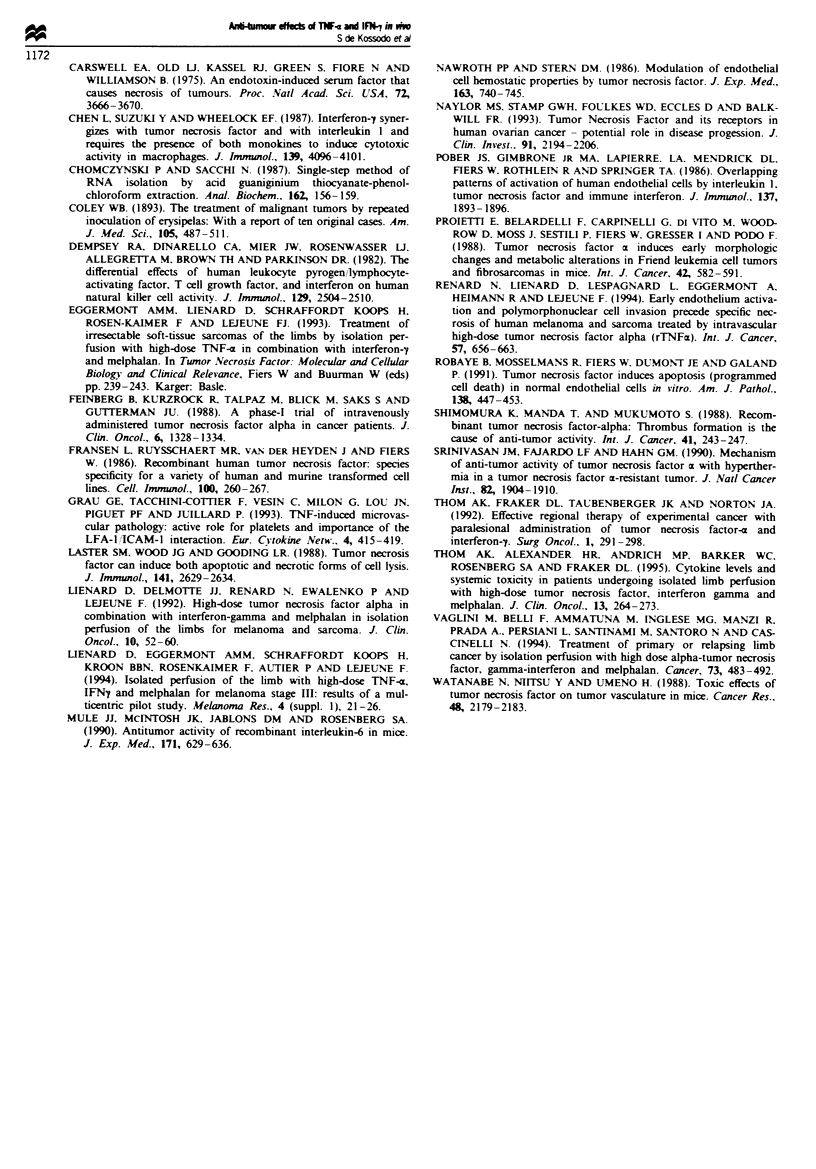
Images in this article
Selected References
These references are in PubMed. This may not be the complete list of references from this article.
- Aune T. M., Pogue S. L. Inhibition of tumor cell growth by interferon-gamma is mediated by two distinct mechanisms dependent upon oxygen tension: induction of tryptophan degradation and depletion of intracellular nicotinamide adenine dinucleotide. J Clin Invest. 1989 Sep;84(3):863–875. doi: 10.1172/JCI114247. [DOI] [PMC free article] [PubMed] [Google Scholar]
- Balkwill F. R., Lee A., Aldam G., Moodie E., Thomas J. A., Tavernier J., Fiers W. Human tumor xenografts treated with recombinant human tumor necrosis factor alone or in combination with interferons. Cancer Res. 1986 Aug;46(8):3990–3993. [PubMed] [Google Scholar]
- Balkwill F. R., Ward B. G., Moodie E., Fiers W. Therapeutic potential of tumor necrosis factor-alpha and gamma-interferon in experimental human ovarian cancer. Cancer Res. 1987 Sep 15;47(18):4755–4758. [PubMed] [Google Scholar]
- Barbara J. A., Smith W. B., Gamble J. R., Van Ostade X., Vandenabeele P., Tavernier J., Fiers W., Vadas M. A., Lopez A. F. Dissociation of TNF-alpha cytotoxic and proinflammatory activities by p55 receptor- and p75 receptor-selective TNF-alpha mutants. EMBO J. 1994 Feb 15;13(4):843–850. doi: 10.1002/j.1460-2075.1994.tb06327.x. [DOI] [PMC free article] [PubMed] [Google Scholar]
- Bellomo G., Perotti M., Taddei F., Mirabelli F., Finardi G., Nicotera P., Orrenius S. Tumor necrosis factor alpha induces apoptosis in mammary adenocarcinoma cells by an increase in intranuclear free Ca2+ concentration and DNA fragmentation. Cancer Res. 1992 Mar 1;52(5):1342–1346. [PubMed] [Google Scholar]
- Bevilacqua M. P. Endothelial-leukocyte adhesion molecules. Annu Rev Immunol. 1993;11:767–804. doi: 10.1146/annurev.iy.11.040193.004003. [DOI] [PubMed] [Google Scholar]
- Brouckaert P. G., Leroux-Roels G. G., Guisez Y., Tavernier J., Fiers W. In vivo anti-tumour activity of recombinant human and murine TNF, alone and in combination with murine IFN-gamma, on a syngeneic murine melanoma. Int J Cancer. 1986 Nov 15;38(5):763–769. doi: 10.1002/ijc.2910380521. [DOI] [PubMed] [Google Scholar]
- Brouckaert P., Spriggs D. R., Demetri G., Kufe D. W., Fiers W. Circulating interleukin 6 during a continuous infusion of tumor necrosis factor and interferon gamma. J Exp Med. 1989 Jun 1;169(6):2257–2262. doi: 10.1084/jem.169.6.2257. [DOI] [PMC free article] [PubMed] [Google Scholar]
- Cajot J. F., Kruithof E. K., Schleuning W. D., Sordat B., Bachmann F. Plasminogen activators, plasminogen activator inhibitors and procoagulant analyzed in twenty human tumor cell lines. Int J Cancer. 1986 Nov 15;38(5):719–727. doi: 10.1002/ijc.2910380516. [DOI] [PubMed] [Google Scholar]
- Carswell E. A., Old L. J., Kassel R. L., Green S., Fiore N., Williamson B. An endotoxin-induced serum factor that causes necrosis of tumors. Proc Natl Acad Sci U S A. 1975 Sep;72(9):3666–3670. doi: 10.1073/pnas.72.9.3666. [DOI] [PMC free article] [PubMed] [Google Scholar]
- Chen L., Suzuki Y., Wheelock E. F. Interferon-gamma synergizes with tumor necrosis factor and with interleukin 1 and requires the presence of both monokines to induce antitumor cytotoxic activity in macrophages. J Immunol. 1987 Dec 15;139(12):4096–4101. [PubMed] [Google Scholar]
- Chomczynski P., Sacchi N. Single-step method of RNA isolation by acid guanidinium thiocyanate-phenol-chloroform extraction. Anal Biochem. 1987 Apr;162(1):156–159. doi: 10.1006/abio.1987.9999. [DOI] [PubMed] [Google Scholar]
- Dempsey R. A., Dinarello C. A., Mier J. W., Rosenwasser L. J., Allegretta M., Brown T. E., Parkinson D. R. The differential effects of human leukocyte pyrogen/lymphocyte-activating factor, T cell growth factor, and interferon on human natural killer activity. J Immunol. 1982 Dec;129(6):2504–2510. [PubMed] [Google Scholar]
- Feinberg B., Kurzrock R., Talpaz M., Blick M., Saks S., Gutterman J. U. A phase I trial of intravenously-administered recombinant tumor necrosis factor-alpha in cancer patients. J Clin Oncol. 1988 Aug;6(8):1328–1334. doi: 10.1200/JCO.1988.6.8.1328. [DOI] [PubMed] [Google Scholar]
- Fransen L., Ruysschaert M. R., Van der Heyden J., Fiers W. Recombinant tumor necrosis factor: species specificity for a variety of human and murine transformed cell lines. Cell Immunol. 1986 Jun;100(1):260–267. doi: 10.1016/0008-8749(86)90025-0. [DOI] [PubMed] [Google Scholar]
- Grau G. E., Tacchini-Cottier F., Vesin C., Milon G., Lou J. N., Piguet P. F., Juillard P. TNF-induced microvascular pathology: active role for platelets and importance of the LFA-1/ICAM-1 interaction. Eur Cytokine Netw. 1993 Nov-Dec;4(6):415–419. [PubMed] [Google Scholar]
- Laster S. M., Wood J. G., Gooding L. R. Tumor necrosis factor can induce both apoptic and necrotic forms of cell lysis. J Immunol. 1988 Oct 15;141(8):2629–2634. [PubMed] [Google Scholar]
- Lienard D., Ewalenko P., Delmotte J. J., Renard N., Lejeune F. J. High-dose recombinant tumor necrosis factor alpha in combination with interferon gamma and melphalan in isolation perfusion of the limbs for melanoma and sarcoma. J Clin Oncol. 1992 Jan;10(1):52–60. doi: 10.1200/JCO.1992.10.1.52. [DOI] [PubMed] [Google Scholar]
- Liénard D., Eggermont A. M., Schraffordt Koops H., Kroon B. B., Rosenkaimer F., Autier P., Lejeune F. J. Isolated perfusion of the limb with high-dose tumour necrosis factor-alpha (TNF-alpha), interferon-gamma (IFN-gamma) and melphalan for melanoma stage III. Results of a multi-centre pilot study. Melanoma Res. 1994 Mar;4 (Suppl 1):21–26. [PubMed] [Google Scholar]
- Mulé J. J., McIntosh J. K., Jablons D. M., Rosenberg S. A. Antitumor activity of recombinant interleukin 6 in mice. J Exp Med. 1990 Mar 1;171(3):629–636. doi: 10.1084/jem.171.3.629. [DOI] [PMC free article] [PubMed] [Google Scholar]
- Nawroth P. P., Stern D. M. Modulation of endothelial cell hemostatic properties by tumor necrosis factor. J Exp Med. 1986 Mar 1;163(3):740–745. doi: 10.1084/jem.163.3.740. [DOI] [PMC free article] [PubMed] [Google Scholar]
- Naylor M. S., Stamp G. W., Foulkes W. D., Eccles D., Balkwill F. R. Tumor necrosis factor and its receptors in human ovarian cancer. Potential role in disease progression. J Clin Invest. 1993 May;91(5):2194–2206. doi: 10.1172/JCI116446. [DOI] [PMC free article] [PubMed] [Google Scholar]
- Pober J. S., Gimbrone M. A., Jr, Lapierre L. A., Mendrick D. L., Fiers W., Rothlein R., Springer T. A. Overlapping patterns of activation of human endothelial cells by interleukin 1, tumor necrosis factor, and immune interferon. J Immunol. 1986 Sep 15;137(6):1893–1896. [PubMed] [Google Scholar]
- Proietti E., Belardelli F., Carpinelli G., Di Vito M., Woodrow D., Moss J., Sestili P., Fiers W., Gresser I., Podo F. Tumor necrosis factor alpha induces early morphologic and metabolic alterations in Friend leukemia cell tumors and fibrosarcomas in mice. Int J Cancer. 1988 Oct 15;42(4):582–591. doi: 10.1002/ijc.2910420420. [DOI] [PubMed] [Google Scholar]
- Renard N., Liénard D., Lespagnard L., Eggermont A., Heimann R., Lejeune F. Early endothelium activation and polymorphonuclear cell invasion precede specific necrosis of human melanoma and sarcoma treated by intravascular high-dose tumour necrosis factor alpha (rTNF alpha). Int J Cancer. 1994 Jun 1;57(5):656–663. doi: 10.1002/ijc.2910570508. [DOI] [PubMed] [Google Scholar]
- Robaye B., Mosselmans R., Fiers W., Dumont J. E., Galand P. Tumor necrosis factor induces apoptosis (programmed cell death) in normal endothelial cells in vitro. Am J Pathol. 1991 Feb;138(2):447–453. [PMC free article] [PubMed] [Google Scholar]
- Shimomura K., Manda T., Mukumoto S., Kobayashi K., Nakano K., Mori J. Recombinant human tumor necrosis factor-alpha: thrombus formation is a cause of anti-tumor activity. Int J Cancer. 1988 Feb 15;41(2):243–247. doi: 10.1002/ijc.2910410215. [DOI] [PubMed] [Google Scholar]
- Srinivasan J. M., Fajardo L. F., Hahn G. M. Mechanism of antitumor activity of tumor necrosis factor alpha with hyperthermia in a tumor necrosis factor alpha-resistant tumor. J Natl Cancer Inst. 1990 Dec 19;82(24):1904–1910. doi: 10.1093/jnci/82.24.1904. [DOI] [PubMed] [Google Scholar]
- Thom A. K., Alexander H. R., Andrich M. P., Barker W. C., Rosenberg S. A., Fraker D. L. Cytokine levels and systemic toxicity in patients undergoing isolated limb perfusion with high-dose tumor necrosis factor, interferon gamma, and melphalan. J Clin Oncol. 1995 Jan;13(1):264–273. doi: 10.1200/JCO.1995.13.1.264. [DOI] [PubMed] [Google Scholar]
- Thom A. K., Fraker D. L., Taubenberger J. K., Norton J. A. Effective regional therapy of experimental cancer with paralesional administration of tumour necrosis factor-alpha + interferon-gamma. Surg Oncol. 1992 Aug;1(4):291–298. doi: 10.1016/0960-7404(92)90090-8. [DOI] [PubMed] [Google Scholar]
- Vaglini M., Belli F., Ammatuna M., Inglese M. G., Manzi R., Prada A., Persiani L., Santinami M., Santoro N., Cascinelli N. Treatment of primary or relapsing limb cancer by isolation perfusion with high-dose alpha-tumor necrosis factor, gamma-interferon, and melphalan. Cancer. 1994 Jan 15;73(2):483–492. doi: 10.1002/1097-0142(19940115)73:2<483::aid-cncr2820730238>3.0.co;2-s. [DOI] [PubMed] [Google Scholar]
- Watanabe N., Niitsu Y., Umeno H., Kuriyama H., Neda H., Yamauchi N., Maeda M., Urushizaki I. Toxic effect of tumor necrosis factor on tumor vasculature in mice. Cancer Res. 1988 Apr 15;48(8):2179–2183. [PubMed] [Google Scholar]



